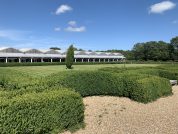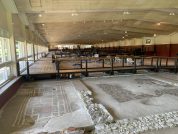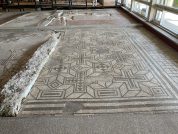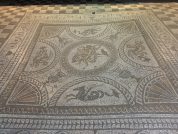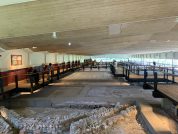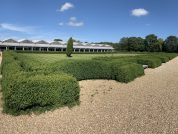Fishbourne Roman Palace (Villa Regis Cogidubni)
Supply Depot and Villa
Fishbourne Roman Palace (or Fishbourne Villa) is located in the village of Fishbourne, Chichester in West Sussex. The palace is the largest Roman residence north of the Alps and has an unusually early date of 75 CE, around thirty years after the Roman conquest of Britain. Much of the palace has been excavated and is preserved, along with an on-site museum. The rectangular palace surrounded formal gardens, the northern parts of which have been reconstructed. Extensive alterations were made in the second and third centuries CE, when many of the original black and white mosaics were overlaid with more sophisticated coloured work, including the perfectly preserved Dolphin mosaic in the north wing. More alterations were in progress when the palace burnt down in around 270 CE, after which it was abandoned.
History of Fishbourne Roman Palace
Pre Roman Fishbourne
The site lies at the head of a fine natural harbour created by the gradual submergence of the land following the last period of glaciation. In the silt below the roman shoreline the remains of flints used by earlier Mesolithic and Neolithic populations. By the first century BC a community of traders seem to have developed here.
The location of Fishbourne, in proximity to Chichester (Noviomagus Reginorum), is often looked to when discussing the opulent wealth represented at Fishbourne as well as solidification for the claim of Cogidubnus as the villa owner. The city of Chichester was in the heart of the dominant Atrebates tribe, but their early introduction to Roman imperialism created a pseudo-friendly relationship between the Romans and the Atrebates. The tribal people in the area were later called the Regni after being ruled by Roman client kings for so long. Fishbourne palace may have possibly been designated as a “seat of lordship”, which meant that it may have had greater financial and social authority as opposed to other palaces or villas in its vicinity. Furthermore, the palace’s proximity to the Fishbourne channel, which provided ships with access to the sea, meant that it could have potentially had its own harbour that received trading ships at one point.
Claudian Supply Base 43AD
The initial Roman buildings formed part of a military supply base, which was combined with the nearby deepwater anchorage site and was built during the initial Claudian invasion of south-east Britain. The campaigns on the south coast were conducted by the future emperor Vespasian, at this time known merely as the legate Titus Flavius Vespasianus, who was placed in command of the The Second Augustan Legion (Legio Secundae Augusta).
The first buildings on the Fishbourne site were timber-built granaries over 33 m (108 ft) long. These timber buildings were possibly built as early as the winter of 43/44AD, during the early governorship of Aulus Plautius.
Fishbourne Roman Palace 60AD
Later, two residential timber-frame buildings were constructed near the site, one of which had clay and mortar floors and plaster walls and was likely quite comfortable. Around 60 AD, these buildings were demolished and replaced by an elaborate and substantial stone-walled villa, or proto-palace. This structure included a courtyard garden with colonnades, a bath suite, and two other buildings, all constructed with materials taken from the earlier buildings. It was decorated with wall paintings, stucco mouldings, and opus sectile marble polychrome panels. A life-size head of a young man carved in marble, likely a likeness of Nero aged 13, was found during excavations, indicating that foreign, likely Italian, craftsmen had to be employed.
This proto-palace was then incorporated into a full-size palace that was built in around 75–80 CE, taking five years to complete. This palace had four residential wings surrounding a formal courtyard garden of 250 by 320 feet (75 by 100 metres). The gardens were surrounded by colonnades in the form of a peristyle. The site had to be leveled up to 5 feet (1.5 metres) in places in order to accommodate the new palace.
The north and east wings each consisted of suites of rooms built around courtyards, with a monumental entrance in the middle of the east wing. In the north-east corner was a huge aisled assembly hall. The west wing contained state rooms, a large ceremonial reception room, and a gallery. The south wing probably contained the owner’s private apartments although the north wing has the most elaborate visible mosaics. The palace included as many as 50 excellent mosaic floors, under-floor central heating and an integral bathhouse. The garden was shown to contain elaborate plantings of shaped beds for hedges and trees with water supplies for fountains. In addition the south wing overlooked a vast artificial terrace laid out as a rectangular garden extending 300 ft towards the sea where there was a quay wall. This garden was planted as a “natural” landscape with trees and shrubs, and with a pond and stream. It also had colonnades on at least one side.
The decoration of the palace was elaborate, including wall paintings, stucco mouldings and opus sectile, marble polychrome panels, examples of which are in the museum. As in the proto-palace, foreign craftsmen had to be employed at this early period.
Fishbourne Roman Palace Divided 2nd Century
The palace outlasted the original owner and was extensively re-modelled early in the 2nd century, and maybe subdivided into two or more separate villas with the addition of a baths suite in the north wing. A remarkable new Medusa mosaic was also laid over an earlier one in the centre of the north wing in about 100 CE.
In the middle of the second century CE, further major redesign included demolition of the recent baths suite and the eastern end of the north wing, probably due to subsidence from underlying earlier infill. New baths were built in the garden and peristyle in front of the east wing and a wall across the garden enclosed the northern half. The north wing was also extensively altered in plan, with four new polychrome mosaics including the Cupid mosaic dating from about 160 CE. Further redevelopment was done at times in the late third century. The final alterations were incomplete when the north wing was destroyed in a fire c. 270 CE.
Who owned the Palace of Fishbourne?
Tiberius Claudius Cogidubnus
The early phase of the palace was the residence of Tiberius Claudius Cogidubnus (or Togidubnus), a pro-Roman local chieftain who was installed as king of a number of territories following the first stage of the conquest. Cogidubnus is known from a reference to his loyalty in Tacitus’s Agricola.
Some of the states were given to king Cogidumnus, who lived down to our day a most faithful ally. So was maintained the ancient and long-recognised practice of the Roman people, which seeks to secure among the instruments of dominion even kings themselves.
Cornelius Tacitus – Agricola 14.1
He is also mentioned in an inscription commemorating a temple dedicated to Neptune and Minerva found in nearby Chichester. The inscription naming a certain Cogidubnus ‘Great King in Britain’.
RIB 91 - Altar dedicated to Neptune and Minerva
To Neptune and Minerva, for the welfare of the Divine House by the authority of Tiberius Claudius Togidubnus, great king of Britain, the guild of smiths and those therein gave this temple from their own resources, Pudens, son of Pudentinus, presenting the site.
TEMPLVM
[...]O SALVTE DO[...] DIVINAE
[...] AVCTORITAT[ ...] CLAVD
[...]GIDVBNI R[... ]AGNI BRIT
[...]GIVM FABROR ET QVI IN EO
[...]Ṭ D S D DONANTE AREAM
[...]ENTE PVDENTINI FIL
Pro salute domus divinae is a very rare formula; see note to RIB 89.Cogidubnus: see 14 quaedam civitates Cogidumno regi donatae.r(egis) (et) legat(i) Aug(usti) in Brit(annia): on this title, which is characteristic of Claudius’ ‘tendency to mingle innovation with conservatism’ see Collingwood and Myres, Roman Britain and the English Settlements (1936) 86.qui in eo [sun]á¹ Huebner suggests that this phrase comprises members who joined in meetings of the guild without possessing all its privileges.Waltzing, Corporations iv 267 lists this phrase among those which indicate membership of a guild, but does not suggest that it implies any difference in status: cf. CIL xii 1929 scaenici Asiaticiani et qui in eodem corpore sunt.
CRAB – Cogidubnus Rex Atrebatum Britanniorum?
Other evidence which seems to confirm the reign of Cogidubnus in Britain comes in the form of two silver coins from the south of England, a stater found at Portsmouth, and a minim found at Hod Hill. Both of these coins are fully Romanised in design, and inscribed with the formula CRAB, which has been expanded to read C[ogidubnus] R[ex] A[trebatum] B[ritanniorum], or ‘Cogidumnus, King of the Atrebates of Britain’. If Cogidubnus was a client king of Rome, as is apparently evidenced, he would have been allowed to issue his own coinage. This practice is not unique to Cogidubnus in post-Iron-age Britain, for king Prasutagus of the Iceni tribe from Norfolk was another client of Rome, and is known also to have produced his own coinage after the 43AD invasion.
Who was Cogidubnus
It is quite likely that Cogidubnus was the descendant and probable heir of king Verica of the Atrebates, a king known by his coinage to be pro-Roman in attitude, who was forced to flee to the protection of Rome c.42AD following his expulsion from Britain by the Trinovantian warlord Caratacus. It is possible that Cogidubnus accompanied his elder relative during his flight to Claudius in Rome, but it is more likely given the enormous trust he was given later on, that Cogidubnus was already known to the imperial court, having been sent to Rome as a hostage to be educated in the ways of Roman society, as was often the case with the heirs of pro-Roman or fully client states.
The successful campaigns of Vespasian in the south-west of England may have been expedited to some extent by the young British prince, recently returned from the continent in the train of the Roman invasion army. As a reward for his stout pro-Roman stance, the young prince was officially made client-king of Rome sometime before the death of the emperor Claudius in 54AD, as evidenced by his adoptive Roman name Tiberius Claudius. This kingship very likely gave the young British prince the tribal territories of his native Atrebates, the neighbouring state of the Regni and possibly also the Belgae, he was also allowed to issue his own coinage.
Given the proximity of the inscribed Chichester stone to the villa at Fishbourne, the opulence of the villa itself, which boasted fine marble transported all the way from Greece and Italy, the testimony of the great historian Tacitus confirming his name and client-status, and also the coinage in the south of England, it is not outside the realms of possibility that the Fishbourne palace was indeed, the residence of the ‘Great King of Britain’, Cogidubnus of the Atrebates.
Sallustius Lucullus
Another possibility may be Sallustius Lucullus, a Roman governor of Britain of the late 1st century who may have been the son of the British prince Adminius. If the palace were designed for Lucullus, then it may have only been in use for a few years, for the Roman historian Suetonius records that Lucullus was executed by the delusional emperor Domitian in or shortly after 93 CE. Two inscriptions recording the presence of Lucullus have been found in nearby Chichester, although RIB 2334 is thought by some to be a fake.
RIB 90 - Altar dedicated to the Genius Loci
Sacred to the Genius (of the place) Lucullus, son of Amminius, set this up from his own resources.
LVCVLLVS
AMMINI FIL
D S P
No commentary.
RIB 2334 - Inscription
Jupiter is the greatest for safety of the emperor Caesar Domitian of August Gaius Sallustius Lucullus the legate of Augustus for the praetor of the province of Britain He willingly and deservedly paid the vow
PRO SALVTE
IMP CAES DOMITIANI
AVG
G SALLVSTIVS LVCVLLVS
LEG AVG
PR PR PROV BRITANNIAE
POSVIT
V S L MQ
Watkin with some doubts accepted it as genuine; Haverfield (see Arch. Oxon.) condemned it.Sallustius Lucullus was governor of Britain about a.d. 93.
Excavations at Fishbourne
The Roman villa at Fishbourne was discovered and excavated in the early 1960’s. The dig revealed a palatial residence with ornate gardens, a large bath suite, many mozaic floors and tesallated pavements, several guest suites arranged around their own courtyards, a spacious entrance-hall and even an audience chamber; truly a residence fit for a king!
Building work on the villa was started in the early 70AD’s, and over the years, additional wings, mozaics and gardens were added, which eventually covered about 4 hectares (10 acres), making Fishbourne one of the largest villas in Britain. The villa was apparently destroyed by fire in the late third century during which lead from the roof of the north wing melted over the surface of the mozaics beneath. After this catastrophic event the villa was abandoned, later becoming the site for a number of late-Roman burials, after many of its carfully prepared building-stones were removed for use in other constructions in the surrounding area.
References for Fishbourne Roman Palace
- Britannia x (1979) pp.243-254;
- The Fishbourne Story by I.D. Margary in Britannia ii (1971) pp.117-121;
- Agricola by Cornelius Tacitus, translated by M. Hutton (Loeb, Harvard, 1914, revised 1970);
- The Romans in Britain – An Anthology of Inscriptions by A.R. Burn (Blackwell, Oxford, 1969);
- The Roman Inscriptions of Britain by R.G. Collingwood and R.P. Wright (Oxford 1965).
Map References for Fishbourne Roman Palace
NGRef: SU8304 OSMap: LR197
Roman Roads near Fishbourne Roman Palace
E (1.25) to Noviomagvs Regnorvm (Chichester, West Sussex) WNW (28) to Clavsentvm (Bitterne, Hampshire)
Sites near Fishbourne Roman Palace (Villa Regis Cogidubni)
- Chichester (Noviomagus Reginorum) (2 km)
British Capital and Port - Bosham Harbour (Magnus Portus) (3 km)
Port - Hayling Island Temple (12 km)
Temple Or Shrine - Selsey Bill Settlement (13 km)
Probable Settlement - Butser Ancient Farm (17 km)
Museum - Bignor Roman Villa (18 km)
Villa - Iping Settlement (21 km)
Mansio - Portchester (Portus Adurni) Roman Fort (21 km)
Saxon Shore Fort - Stroud Villa (22 km)
Temple Or Shrine and Villa - Hardham Roman Settlement (23 km)
Mansio and Minor Settlement
Visiting Fishbourne Roman Palace (Villa Regis Cogidubni)
Opening Hours – from 17th May 2021
March to September 10.00am to 5.00pm
February, October and November 10.00am to 4.00pm
Last Admission 30 minutes before closure
£10.90 / Adult
